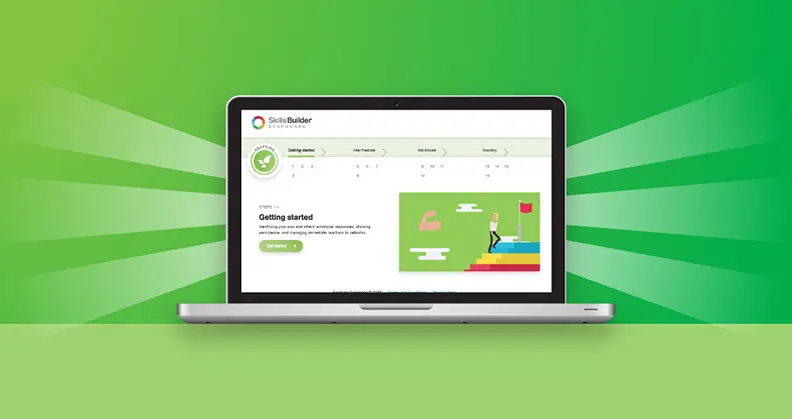None of us ever want something to go wrong. But unfortunately, in life, there are things that are far beyond our control, and so it is inevitable that sometimes things do go wrong or we face setbacks. When this happens, we can feel sad, angry or scared and the natural response can be to take ourselves out of the situation and do something else. To give up!
This is no different for learners in your classroom. When learners are facing setbacks, you, as their teacher, can play an influential role in helping them to identify the negative emotions they are feeling in response, and coach them to continue to persist even in the face of setbacks; in other words developing the skill of staying positive.
What does staying positive mean?
Staying positive is the ability to use tactics and strategies to overcome setbacks and achieve goals. This essential skill is about being equipped to manage emotions effectively and being able to remain motivated when facing setbacks.
Building a staying positive mindset in learners
When something goes wrong, our learners (like us) can swing into feeling negative emotions.
They might feel angry if they feel that it was unfair that this setback happened. Perhaps they feel that someone else was to blame, or that they are being unfairly punished for something. They may feel an energy to try to put it right or get some sort of justice or fairness back.
Alternatively, they might feel scared. Perhaps they don’t know what to do next, or feel that if something bad has happened once, then more bad things might happen again.
Sometimes, a learner will have a combination of all of these emotions. It is important to help learners to develop strategies so that their emotional responses don’t overwhelm them.
Strategies to help learners build a staying positive mindset:
- Help them recognise their emotions and why they feel like that: Getting your learners to name their feelings can be very helpful in understanding and eventually managing them. Students could have an emotion wall or worksheet that they use to help them identify their emotions.
- Encourage them to focus on what has been going well: While there might have been a setback, there are probably also lots of things that have been going well. It’s important that learners don’t lose sight of the positive things when something has been going well. Encourage your learners to reflect on what went well during a task, especially one that involved a setback.
- Identify a positive action: Discuss with your learners what they could do next, which would be a positive way forward.
Helping learners to stay calm
Something not working or going wrong can be an opportunity to learn. For your learners to be ready to learn lessons when something goes wrong, they must first get into an emotional state where they can think clearly and rationally about what has happened. Being able to think rationally means being able to think in a sensible and logical way.
Being calm after a setback is helpful because it gives your learners space to think about the setback or problem and to think through what could be done instead. It is tough to make good plans or develop new ideas if you are not feeling calm first. Helping your learners to stay calm is important if they are to be ready to learn from their setback.
If your learners often feel angry after a setback or problem there are a few activities you could do with them to help them practise being calm and staying positive:
Strategies to help learners stay calm:
- Introduce the idea of staying calm to learners by reminding them about the different positive and negative emotions they might feel at different times: happy, excited, calm, sad, angry, or scared.
– You could use an emotions wall or worksheet to help learners identify their emotions at different times.
- Let your learners know that calming down is a choice and it will take thoughtful effort and energy.
- Talk learners through different setbacks they might encounter that might lead them to feel angry or scared, and then what the subsequent consequences might be.
– For example learners could reflect on a time they have felt angry or scared and what they then did and how that made the situation worse.
- Ask learners for any suggestions that they might have about how to reduce their feelings of anger or fear in the face of a setback.
– You could create a class list or poster.
– You could organise a calm corner- a place learners can go to if they feel they need to calm down.
– Other suggestions: going for a walk, thinking of a happy memory, focusing on breathing slowly, counting in your head, talking to a friend or doing some physical activity.
Learning from setbacks and staying positive:
The learning that can happen when something goes wrong might come from several places:
- Your learner might have made a mistake, and this is what led to something going wrong. They can learn not to make the same mistake again in the future – for example, If they did not do as well as they had hoped to in a test, they could learn the need to revise more in the future.
- The thing that went wrong might have been out of your learners control, but looking back, they might have been able to have done something to be ready in case it happened. This is called being aware of risk, where risks are things that could go wrong.
- Your learners might learn something new about themselves – for example, they might see that when they are late, they get upset or angry. In this case, they can recognise these emotions better in the future and take steps to calm themselves down.
- In science, the process of learning is driven as much as by things that do not work, as things that do. Science is all about creating ideas and then testing them through lots of different experiments. Most of the ideas that people come up with are wrong – but they test them to find out
How to help your learners learn from their setbacks:
Asking your learners reflective questions can be a great way to get them to think about what they have learnt from a setback.
Remind learners of the importance of getting back into a positive, or at least neutral, emotional state before they can think about what happened and review it.
You could model an example of each of the different types of learning that can take place and learners could share their own examples from their experience at school or from their wider lives.
There are different types of questions you could use to get learners to reflect:
Analysing the situation itself:
- What happened?
- Why does it feel that something has gone wrong?
- What is the effect of that happening?
- What role did I play in the events, and what was out of my control?
Understanding if anything could have prevented it
- Could I have predicted that would happen?
- What could I have done to prevent that happening?
Consolidating what learning to take into the future
- What do I know now that I did not know before?
- What would I recommend that others do or don’t do based on my experience?
- How will I make sure I put what I have learned into use to help me?
Learners could analyse a created scenario – either alone, or in groups to practise doing this.
Carrying out this sort of analysis, once calm, means that even when something goes wrong, your learners can take something positive out of it – some useful learning that they can use in the future.
Why staying positive matters in the classroom
Learning can be challenging. It is not always possible to get everything right the first time and things will go wrong. When taking in lots of information, which might be complicated and tricky to understand, your learners may begin to feel overwhelmed, frustrated, or anxious.
As teachers, we can help our learners think about how to be resilient - how to keep going despite feeling negative emotions. Helping learners to stay calm when things feel like they are going wrong in their educational setting can help them to stay focused on the positive emotions.
When something does go wrong there is learning that can be taken from that experience. The most important part of learning lessons when something goes wrong is about having the attitude of staying positive and wanting to learn those lessons. In education staying positive is important if we want our learners to continue to learn and develop.
You can access teaching resources for building Staying Positive on Skills Builder Hub.






